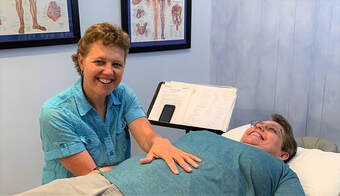Integrative Manual Therapy

Integrative Manual Therapy (IMT) is a manual therapy approach. A hands-on technique to healing and recovery. IMT is a combination of diagnostic and treatment methodologies that assess and treat pain, dysfunction, disease, and disability. Therapists utilizing the IMT approach, assess patients by using manual (hands-on) diagnostic techniques.
IMT diagnostics assess the body's anatomic and physiologic systems independently as well as investigate how these systems are interrelated for each patient's pattern of dysfunction or disease. The diagnostics evaluate various inherent rhythms in the body (biologic rhythms, circadian rhythms, or motilities) to assess different systems in the body such as lymphatic, nervous, facial, muscle, circulatory, and more. This helps the therapist understand what systems are involved in the dysfunction or disease and to establish a comprehensive customized treatment plan.
IMT treatment techniques are manual (hands-on) and involve gentle manipulative/light touch techniques to promote tissue repair, normalize anatomy (the structures of the body) and physiology (how the body works) and help restore function. The treatment of anatomy includes manual techniques for bones, ligaments, discs, nerves, arteries, veins, organs, and more. The treatment of physiology is to promote normalization of biochemistry using both manual techniques and nutritional wellness programs. More specifically, IMT techniques generally put specific forces or torques into the tissue of the body in order to create an environment within those tissues which is conducive for tissue repair to occur thus improving the structure and ultimately the function of the body.
A unique feature of IMT is in the way it integrates structural and functional rehabilitation approaches. Traditional rehabilitation generally focuses on optimizing function such as strength, balance, coordination, range of motion, and more. Despite the fact that at patient may have structures such as ligament, disc, bone, blood vessels, and more, which are compromised. While functional approaches play a huge role in the rehabilitation process, clinical results show that in the short and long term, to obtain optimal healing and rehabilitation, structural integrity should first be restored to the damaged structure/tissue in order to optimize function. This is what the IMT approach focuses on - restoring the structure in order to obtain the function!
IMT diagnostics assess the body's anatomic and physiologic systems independently as well as investigate how these systems are interrelated for each patient's pattern of dysfunction or disease. The diagnostics evaluate various inherent rhythms in the body (biologic rhythms, circadian rhythms, or motilities) to assess different systems in the body such as lymphatic, nervous, facial, muscle, circulatory, and more. This helps the therapist understand what systems are involved in the dysfunction or disease and to establish a comprehensive customized treatment plan.
IMT treatment techniques are manual (hands-on) and involve gentle manipulative/light touch techniques to promote tissue repair, normalize anatomy (the structures of the body) and physiology (how the body works) and help restore function. The treatment of anatomy includes manual techniques for bones, ligaments, discs, nerves, arteries, veins, organs, and more. The treatment of physiology is to promote normalization of biochemistry using both manual techniques and nutritional wellness programs. More specifically, IMT techniques generally put specific forces or torques into the tissue of the body in order to create an environment within those tissues which is conducive for tissue repair to occur thus improving the structure and ultimately the function of the body.
A unique feature of IMT is in the way it integrates structural and functional rehabilitation approaches. Traditional rehabilitation generally focuses on optimizing function such as strength, balance, coordination, range of motion, and more. Despite the fact that at patient may have structures such as ligament, disc, bone, blood vessels, and more, which are compromised. While functional approaches play a huge role in the rehabilitation process, clinical results show that in the short and long term, to obtain optimal healing and rehabilitation, structural integrity should first be restored to the damaged structure/tissue in order to optimize function. This is what the IMT approach focuses on - restoring the structure in order to obtain the function!
Physical Therapy Unlimited, LLC
785-587-7906
Copyright Physical Therapy Unlimited, LLC. All Rights Reserved.
Privacy Policy Discrimination Policy
785-587-7906
Copyright Physical Therapy Unlimited, LLC. All Rights Reserved.
Privacy Policy Discrimination Policy
